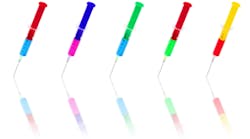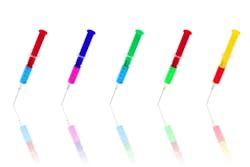Dr. Stacey Simmons: "To save myself from sounding like a fool, let's just say it was an accident and the two-inch gash in my leg—after trying to convince myself that I didn't need stitches—actually did need some fancy needlework, and I was going to have to be the one to do it. Now, how in the world does this apply to dentistry? One word: needles!"
Editor's note: This article first appeared in Breakthrough Clinical, the clinical specialties newsletter created just for dentists. Browse our newsletter archives to find out more and subscribe here.
To save myself from sounding like a fool, let's just say it was an accident and the two-inch gash in my leg—after trying to convince myself that I didn't need stitches—actually did need some fancy needlework, and I was going to have to be the one to do it. Now, how in the world does this apply to dentistry?
One word: needles!
Think about it—those little tiny, shiny, poky, sharp objects that deliver the magic juice, which subsequently allows us to do our job, strike fear in almost every one of our patients. For some, oral sedation is necessary. Nitrous is a bonus if you offer it. For kiddos—ha! I’ve seen some parents have to practically drag their kids out of the car into the dental office (can you say referral?). In extreme cases, the dreaded shot completely eliminates some patients from even picking up the phone to schedule any dental work at all unless it’s an absolute emergency.
Getting back to my story...
Personally, I’ve only received local anesthetic two times in my mouth—when I had my wisdom teeth pulled and when I was a student guinea pig in dental school. I’ve never had a cavity or major dental work, so, in a way, that puts me at a disadvantage; I really don’t know what my patients are experiencing. It’s along the same lines as when a male OB explains to his patient what it’s like being pregnant and giving birth (right, ladies?)! Until you experience it, you just don’t know.
I’ve delivered local a million times, and I never gave it a second thought...until now. I was shaking. I hesitated. I was breathing hard, and when I delivered that first little poke with the needle, it was horrible. The worst part was knowing that I had to go all the way around the wound. To make it less painful, I delivered each injection at the edges of the previous one.
Now, for the stitches. Again, that's something I’ve done a million times! I will say that bringing the edges of the wound together on myself was something I hope never to repeat. I’d rather beat myself up over 30-plus miles running an obstacle course race than to do that again.
In the end, however, I survived. Granted, this was a tad different than needles and stitches in the mouth, but it gave me a fresh insight and an appreciation for what my patients go through when they have oral surgery. Patients love hearing our thoughts on what it’s like for us to be in their shoes. That Dryz, yup...it's very nasty make-me-want-to-gag stuff. The mint fluoride, well, if you like root beer, it’s your flavor; otherwise, you should try the piña colada. I believe you get my drift.
Bottom line, few people walk through our doors with a bounce in their step because they’re excited to see us. Patients will always remember how we made them feel during their times of anxiety and concern. If we can achieve positive experiences through our own personal stories and perspectives, it will allow our patients to see us as humans and not just people in white coats or scrubs.
Stacey L. Simmons, DDS
Editorial Director, Breakthrough Clinical
LAST MONTH >> 'I didn't want to be THAT dentist...'
Editor's note: This article first appeared in Breakthrough Clinical, the clinical specialties newsletter created just for dentists. Browse our newsletter archives to find out more and subscribe here.









